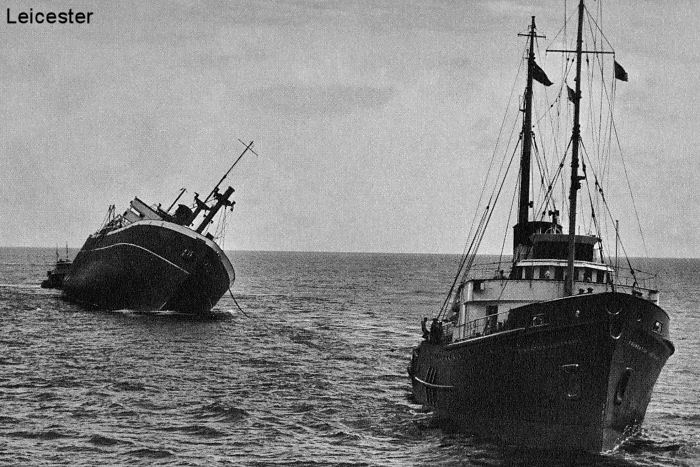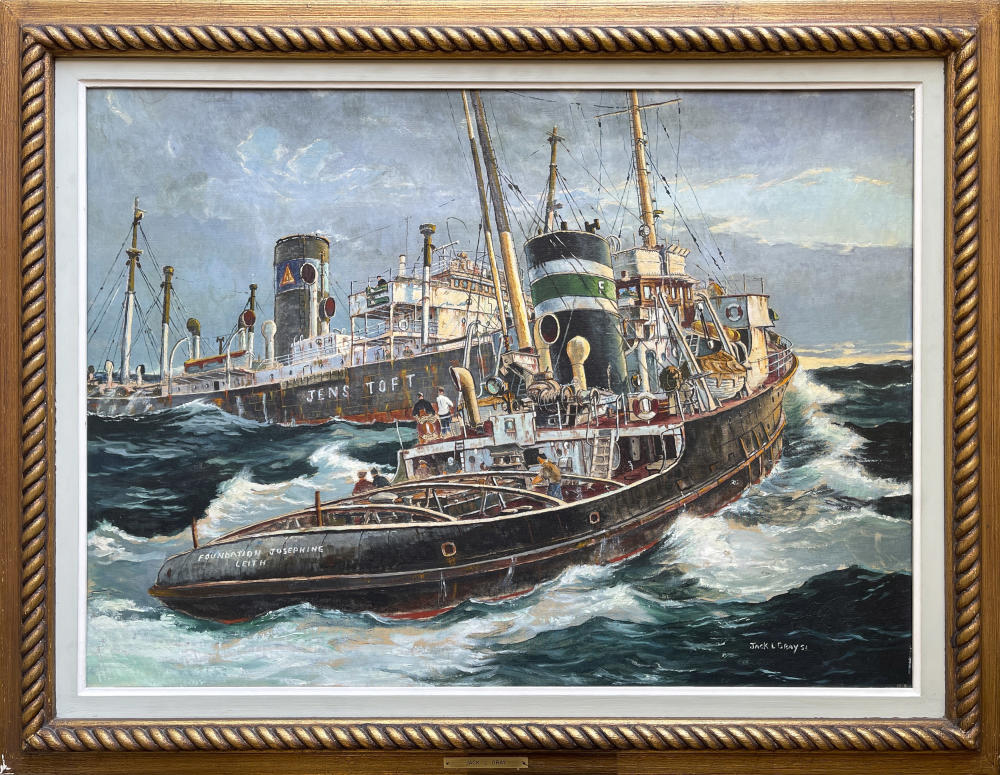-
Œuvres d'art
 With "Josephine" in front and "Lillian" partly obscured behind "Leicester", the tow continues.
http://www.hazegray.org/navhist/canada/fm/salvage/leicester3.jpg
Jack GraySalvage Vessel Foundation Josephine, 19511927-1981Oil on canvas22 x 30 in
With "Josephine" in front and "Lillian" partly obscured behind "Leicester", the tow continues.
http://www.hazegray.org/navhist/canada/fm/salvage/leicester3.jpg
Jack GraySalvage Vessel Foundation Josephine, 19511927-1981Oil on canvas22 x 30 in
55.9 x 76.2 cmSoldInscriptions
signed and dated, ‘JACK L GRAY 51’ (lower right); inscribed, ‘ R.E. Chadwick. / 18 Ramsay Rd. - /F. -7891’ (verso, lower left quadrant)Provenance
Walter Klinkhoff Gallery Inc., Montreal;
Acquired from the above by the present owner.
The Foundation Josephine is an outstanding painting by Jack L. Gray who is among the foremost maritime artists in North America of the post WWII era. The tug boat Foundation Josephine was one of the kind of marine wreck salvage vessels that has become legend in the writings of Farley Mowat’s "The Serpent's Coil"; “‘She wasn't no boat at all by then,’ a mariner on the sea-rescue tug called the Foundation Josephine recalls -- ‘she was a bloody airplane what couldn't quite take off. I never seen nothing like it in twenty-seven years at sea.’[1]” The tug was owned by Foundation Wreck and Salvage, a company in a large part owned by Richard E. Chadwick (1885- 1966), an engineer originally from Toronto and a great Canadian business success story of his day. The Josephine is named after Mr. Chadwick’s wife.
_________________________________
Jack L Gray 1927 - 1981
Gray was born and raised in Halifax, where he studied for two years at the Nova Scotia School of Art and Design. Subsequently Gray moved to Montreal and, according to his great friend of the day, Montreal artist John Little, while they took classes together at the Montreal Museum of Fine Arts under the teaching of Arthur Lismer, Gray was staying at the downtown YMCA. Little maintains that despite Gray’s relative youth, he was already a mature artist. (Little has other wonderful stories about his good friend, ones the author will recount in another platform). Gray is responsible for introducing John Little to Lorraine McMahon in LaHave, Nova Scotia, a lovely young lady who he would marry the following year.
"During his student days he worked as a deckhand and was always close to the subject he loved. He sketched schooners and the fisherfolk of Halifax Harbour and exhibited some of his canvases at the Montreal Art Association in 1945. The following year he held his first one man show at Hackmatack Inn, N.S., through the help of two of his friends, George Baker and Marty Allen. A larger one man show of his work took place at Chester, Nova Scotia, in 1948 which attracted national attention. Gray purchased his first fishing boat about this time which allowed him more freedom to pursue his subjects. His first art commission was handed to him by the National Sea Products, Ltd., for a series of water colours of beam-trawling. He spent a long bitter winter on the Grand Banks on the schooner Doris Susan, sketching the patient fishermen gathering their sea harvest by the old methods. As the old methods are dying out Gray's paintings have become historically important and are considered by many to be on a par with the writer. word of authors like Frederick William Wallace (Wooden Ships and Iron Men). In 1951 he was commissioned by the Foundation Maritime Limited to paint a scene of its ocean going tug Foundation Josephine and in so doing was able to go with the tug when it was called to the rescue of the Dufferin Bell, a 4,700 ton freighter which had run aground. The Chronicle-Herald reported the scene as follows, “. . . armed with sketchbook and pencil, Jack Gray was on the scene, getting tossed about in a weatherbeaten dory and later a Cape Island fishing boat, sketching firsthand the atmosphere of a first-rate ship pile-up. A stickler for detail, Jack even clambered aboard the creaking and groaning freighter for an on-the-spot look at his “subject.” Further on in the report under the heading of “Top Notch Seaman'' was this account, “and here he showed himself a top-notch seaman, too. His fisherman friend could not see how he could take his boat away from the freighter’s side into clear water. So, Jack grabbed the wheel and did the job for him, then all he had to do was to ink in the sketch on board the Josephine . . . Since the first years of the war, he had been hitching rides on fishing trawlers and the like, filling his sketchbook with ideas for future paintings.” Gray spent some time in Montreal where he did landscapes of the Laurentians for a Montreal art dealer but this was not a happy arrangement for him and he left for New York after his son was born in 1953. They lived on his boat in New York Harbour. There Gray painted 12 canvases which were shown at the Kennedy Galleries in Manhattan in a one man show - causing a minor news sensation in that city. Many celebrities attended including the mayor of New York and the Canadian trade commissioner. Every painting was sold and Gray was able to pay his outstanding debts and buy a good boat when he returned to the Maritimes. He was commissioned in 1958 by the movie producer Samuel Bronston to do 16 paintings in Spain for the movie production of “John Paul Jones.” His part was to do a series of portraits of the stars and battle sequences. To-day Jack Gray owns a motor launch worth $100,000 where he has his studio amidships. In the winter he goes south to the waters of the Bahamas, or to West Palm Beach, Florida. He has done scenes in many other parts of [sic] United States including California. But when summer arrives he is back in Nova Scotia painting the ships and people he loves. He is considered to be one the finest marine painters of our time.[2]"
According to "A Dictionary of Canadian Artists", Gray’s paintings are in numerous museums and private collections including The Royal Canadian Navy, The United States Marine Corps Museum, The Museum of the City of New York, The Peabody Museum, Mass., The Family of the Late John F. Kennedy, the Family of the Late J. P. Getty, The Family of the Late Mr and Mrs Norman Woolworth, The Family of The Late Prince Bertil, Duke of Hallard, Stockholm.
The gentleman for whom Josephine was painted is a legend in his own right. Richard E. Chadwick’s story is wonderfully recounted in “The Man Who Robs Davy Jones [3]” in Maclean’s “The Spectacular Story of Canada’s Biggest Builder.”
It is a story of a great Canadian business success. It also explains to laypeople who know little or nothing about the business of marine salvaging and its importance not only in saving lives but also in saving insurance companies enormous sums of money. Foundation Josephine was one of those vessels that performed some heroic jobs the likes of which are related in Farley Mowat’s “Serpent’s Coil”.
In summary, Richard Chadwick was Toronto-born, an engineer, one aspiring to a career in construction, who moved to New York where he apprenticed with the Foundation company, an American-based firm specialized in the design and construction of foundations for the new generation of skyscrapers being built. While Chadwick was working on what was to be New York City’s tallest building of the day, the Woolworth Building, he was asked to go to Montreal and participate in some work the Canadian subsidiary was doing at Canadian Pacific Railway's Windsor station. The short story is that ultimately Chadwick, supported by other investors, purchased the Canadian subsidiary of the Foundation company. The company of which he was president evolved into building not only foundations of buildings but construction of them as well, including Montreal’s Aldred Building. The story goes that while working building piers and wharves and foundations for bridges there was a need for various water worthy vessels for the work. Then, noticing the business opportunity represented by salvaging and rescuing ships, Chadwick bought his Foundation’s first salvage tug.
We encourage interested readers to pull up the Maclean’s article. If one wishes to pursue the distraction, the article makes for a good read. _________________________________
Endnotes1. Farley Mowat, "The Serpent's Coil", (New-York: Lyons Press, 2001 (1961))2. Colin S. MacDonald, 1967. "A Dictionary of Canadian Artists". Vol. 2, "G to Jackson" (Ottawa: Canadian Paperbacks), pp. 309-3103. Anglin, Gerald. "The Man Who Robs Davy Jones." Maclean's, April 1, 1950, pp. 20, 30-31. (https://archive.macleans.ca/article/1950/4/1/the-man-who-robs-davy-jones)1sur 2


















